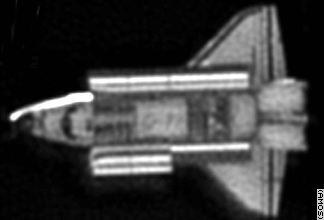Sean O'Keefe testified on Thursday, 27/2/2003 before the Senate Science Committee, which is also investigating the disaster
 This image is one of several images of Space Shuttle Columbia taken from the US Air Force Optics and Supercomputing Facility in Maui, Hawaii. The images were taken on January 28, while the shuttle was in orbit, four days before it disintegrated upon re-entry. The suspected damage to the shuttle is on the other side of the spacecraft, and is not visible in the photo, because the shuttle's orbit is upside down.
This image is one of several images of Space Shuttle Columbia taken from the US Air Force Optics and Supercomputing Facility in Maui, Hawaii. The images were taken on January 28, while the shuttle was in orbit, four days before it disintegrated upon re-entry. The suspected damage to the shuttle is on the other side of the spacecraft, and is not visible in the photo, because the shuttle's orbit is upside down.
NASA Administrator Sean O'Keefe came under fire at a congressional hearing on Thursday, February 27, 2, a day after NASA released email exchanges that raised concerns about the shuttle's safety before the Columbia disaster.
In the internal emails, NASA engineers raised concerns that the left wing of the shuttle could burn up and cause the loss of the crew along with it.
These memos, written in the days before the disaster, never reached NASA senior management. "I've read this stuff before you, it's crazy," said New York Republican Congressman Anthony Weiner. Wiener demanded to know why these concerns did not reach O'Keefe while the shuttle was flying. “Would you have fired someone if they had brought it to your attention earlier? I can't think of anything more important on your desk than the functioning of the shuttle," he said. O'Keefe replied that the appropriate experts had examined all the possible problems and decided that there was no danger in the landing.
"We encourage, expect and require our people to exchange opinions and solutions on how to discuss anomalies that occur in flight." O'Keefe said in a hearing before the Congressional Science Committee. "There are many issues we are working on. I can't know about every little discussion going on in the agency. Does every argument in an agency that employs thousands of workers have to come to my desk? This means that I will collapse," he said.
Sherwood Bohlet, chairman of the science committee, commented that it was too early to make accusations. "We need to investigate the e-mail traffic from this mission and previous missions," said Bullert, a Republican from New York.
Annoying questions after launch
After launch on January 16, Columbia's left wing was struck by debris from the external fuel tank. A damage assessment done by Boeing, the shuttle's main contractor, concluded that there was no danger in the landing.
However, disturbing concerns about the damage to the insulation tiles on the bottom of the shuttle convinced mid-level engineers to investigate the possibility of danger upon contact with the ground. "Why are we talking about this one day before landing and not one day after launch," Bill Anderson of United Space Alliance LLC, the shuttle's prime contractor, said in a Jan. 31 memo.
While the group focused on figuring out how to conduct an emergency landing if the landing gear was damaged, Anderson commented that the malfunction could occur much higher. "If the wing falls, or a large hole opens in it, the spacecraft will not be able to reach the landing track and the question of the landing mechanism will be an unnecessary discussion." said.
Hours earlier, Jeffrey Kling, a flight supervisor at the Johnson Space Center, commented that problems were expected with the landing if the fragments in the launch damaged the landing gear or the wheel.
He warned that a crack, which would allow extremely hot gas to enter the shuttle, could blow the wheel door and possibly even affect the inner aluminum structure of the wing with fatal implications.
"Our unequivocal recommendation is that the astronauts should prepare for abandonment, assuming that the wing does not burn before we manage to rescue the crew," he said. In this scenario, he wrote, the shuttle could suffer overtemperature and loss of sensor readings related to air pressure and hydraulic pressure in the wheels.
The next day, Kling was among the controllers in the control room who reported the sudden loss of a series of sensors on the left wing, immediately after an increase in the temperature in the left landing gear area was detected.
Immediately after those email exchanges were revealed, Kling told reporters that the entire team believed the analyzes performed by Boeing engineers, which concluded that the foam that hit the shuttle could not have caused a fatal accident.
"The emails were 'what if' scenarios, where we talked about these issues as if we were doing our normal work. We examine things and ask what will happen, and go over the whole business," he said.
